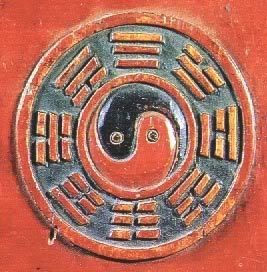
This is a well known Taoist symbol. "It represents the balance of opposites in the universe. When they are equally present, all is calm. When one is outweighed by the other, there is confusion and disarray." One source explains that it was derived from astronomical observations which recorded the shadow of the sun throughout a full year.
The two  swirling shapes inside the symbol give the impression of change -- the only constant factor in the universe. One tradition states that Yin (or Ying; the dark side) represents the breath that formed the earth. Yang (the light side) symbolizes the breath that formed the heavens.
swirling shapes inside the symbol give the impression of change -- the only constant factor in the universe. One tradition states that Yin (or Ying; the dark side) represents the breath that formed the earth. Yang (the light side) symbolizes the breath that formed the heavens.
One source states: "The most traditional view is that 'yin' represents aspects of the feminine: being soft, cool, calm, introspective, and healing... and "yang" the masculine: being hard, hot, energetic, moving, and sometimes aggressive. Another view has the 'yin' representing night and 'yang' day.
Another source offers a different definition: A common misconception in the west is that "...yin is soft and passive and yang is hard and energetic. Really it is yang that is soft and yin that is hard, this is because yang is energetic and yin is passive. Yin is like a rock and yang is like water or air, rock is heavy and hard and air is soft and energetic."
Allan Watts, describes the yin and yang as negative and positive energy poles: "The ideograms indicate the sunny and shady sides of a hill....They are associated with the masculine and the feminine, the firm and the yielding, the strong and the weak, the light and the dark, the rising and the falling, heaven and earth, and they are even recognized in such everyday matters as cooking as the spicy and the bland."
However, since nothing in nature is purely black or purely white, the symbol includes a small black spot in the white swirl, and a corresponding white spot in the black swirl.
Ultimately, the 'yin' and 'yang' can symbolize any two polarized forces in nature. Taosts believe that humans often intervene in nature and upset the balance of Yin and Yang.

No comments:
Post a Comment